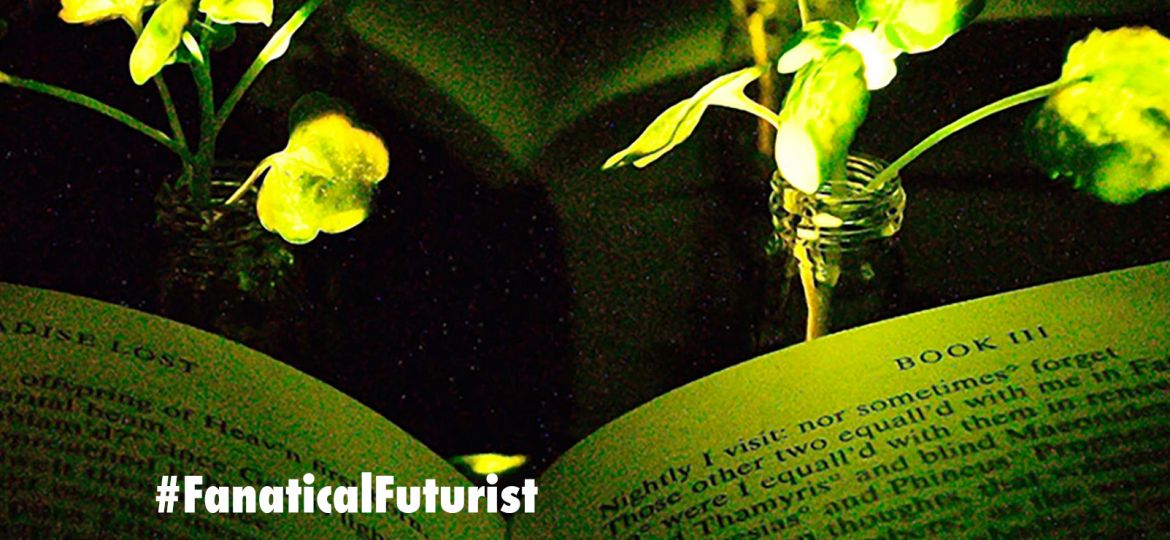
WHY THIS MATTERS IN BRIEF
Around a fifth of all the world’s energy production is consumed by lighting, but in the future glowing plants could help provide us all with an infinite, renewable source of light.
Plants at the moment are getting the royal treatment. They’re being turned into surveillance devices, being given new super growing powers and the ability to come back from the dead, and they’re also being turned into renewable electrical circuits that can be plugged into the electric grid. Now though they’re also about to be turned into the future’s equivalent of street lights. Yep, it’s a great life being a plant, nothing happens for millions of years and Boom! All of a sudden you’re watching people through their windows and powering their TV’s – all at the same time. Awesome.
But do you know what’s more awesome?
Being able to glow like a firefly like the plants in Avatar, and on Wednesday Avatar wannabe plants everywhere had their prayers answered when a team scientists in the US announced they’d made a breakthrough in creating plants that glow so strongly they’ll soon be able to challenge lights in your house. That’s right, throw out your light bulbs, grab the pot plants and take yourself off the grid. Glowing plants are here. And they’re edible too, sort of…
Bin Your Reading Lamps
The scientists in question, from MIT and the University of California, made their announcement in NANO Letters and in their paper they explain the steps they had to go through to get the plants to emit visible light. Furthermore, it turns out that their new technique is far more efficient than previous methods that relied on genetic engineering, and ultimately, they write, their discovery could be easily scaled up to reduce our reliance on artificial lighting.
The glowing plants the team have growing so far include Arugula, Kale, Spinach, and Watercress, and during their initial experiments the team were able to make these salad greens glow for 45 minutes. However, by the time they’d published their paper they’d extended that figure to just under four hours.
The watercress, in particular, produced a level of brightness comparable to half of a commercial LED light, making it 100,000 times brighter than previously genetically engineered tobacco plants.
The plants are able to glow because they were infused with Luciferase, the enzyme responsible for making fireflies glow. In the reaction, Luciferase interacts with a molecule called Luciferin to produce light, and another molecule called Co-enzyme A lets the process happen by removing the reaction by product that can inhibit the glowing effect in the plant. So, in order to get their glowing plants glowing the researchers packaged these molecules into nanoparticles then poured them into a single chemical solution.
Putting the plants into this solution and hitting them with high pressure allowed the molecule infused nanoparticles to enter the tiny pores in the plants leaves, and once they got inside the plant, biological magic happened. Luciferin was released and interacted with the Luciferase, and the chemical reaction caused the plants to glow, just like the in the Avatar forest where Neytiri and Jake Sully first hooked up.
While still in the early stages, the scientists hope that one day this method can be used to replace traditional electric lighting, filling our spaces with indoor plant lighting and trees that act as self powered streetlights, and the team think plants are ideal candidates for turning into natural lightbulbs because they independently generate and store energy as well as repair themselves.
“The vision is to make a plant that will function as a desk lamp — a lamp that you don’t have to plug in,” said study co-author and MIT chemical engineer Michael Strano, Ph.D, “the light is ultimately powered by the energy metabolism of the plant itself.”
Plants have never had so much fun. Smile, you’re on the plant cam.
















